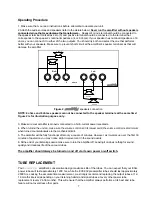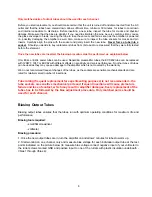
Only matched pairs of output tubes should be used for each channel.
Before you start replacement you should make certain that the unit is turned off and disconnected from the AC
outlet and that the tubes have cooled down. Allow sufficient time, minimum 30 minutes, for tubes to cool down
and internal capacitors to discharge. Before inserting a new tube, inspect the tube for cracks and physical
damage. Make sure that the pins are straight. If you need to straighten the pins, be very careful as it may cause
the glass envelope to break, causing the tube to lose the vacuum and fail as soon as the amplifier is powered
on, possibly damaging the amplifier as well. Also, make sure to inspect the tube sockets for cracks and pin
inserts. Carefully align the pins with the socket and gently insert the new tube.
Never force a tube into a
socket.
Should you decide to buy replacement tubes from Vista Audio, rest assured that they were fully tested
before the shipment.
Once the new tubes are inserted, the biasing procedure must be performed, as explained below.
Only E34L or EL34 power tubes can be used. Regarding preamplifier tubes, the ECC832 tube can be replaced
with 12DW7, 7247 or ECC82 with different effects on sensitivity and sonic performance. No other types of tubes
can be used as they may cause a damage to the amplifier which is not covered by the warranty.
We do not recommend frequent changes of the tubes, as the sockets are sensitive mechanical parts and are
rated for relatively small number of insertions.
Tube rolling (frequent replacement for experimenting purposes) is not recommended – the
tube sockets are sensitive mechanical parts and frequent insertions will cause premature
failure and loss of contact, which may result in amplifier damages. Every replacement of the
tubes has to be followed by the bias adjustment procedure. Only matched pairs should be
used for each channel.
Biasing Output Tubes
Biasing output tubes ensures that the tubes run with optimum operating conditions for maximum life and
performance.
Biasing tools required:
- small flat screwdriver
-
voltmeter
Biasing procedure:
1. Once the new output tubes are in, turn the amplifier on and allow 2 minutes for tubes to warm up.
2. Start working on one channel only and measure bias voltage for each individual output tube at the test
points indicated on the picture below (to measure bias voltage connect negative input of your voltmeter to
the turret screws marked GND and positive input to one of the turrets with plastic insulation underneath -
Vbias 1 through Vbias 4):
8





























